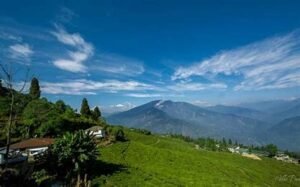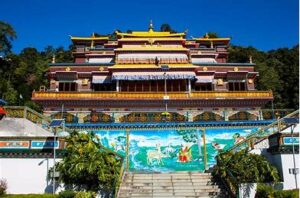Nohkalikai Falls, located in the serene hills of Meghalaya, is not just a beautiful natural landmark, but also holds great cultural and historical significance. It is the tallest plunge waterfall in India, with a height of 1,115 feet (340 meters). This magnificent waterfall is known for its stunning beauty, unique formation, and the rich folklore that surrounds it. In this blog, we will explore various aspects of Nohkalikai Falls, from its historical roots to its cultural importance and its connection to Northeast India.
The Historical Roots of Nohkalikai Falls
The origins of Nohkalikai Falls are deeply rooted in the Khasi culture of Meghalaya. The Khasi people, who are the indigenous community of the region, have a rich history and traditions that date back centuries. Nohkalikai Falls, like many natural landmarks in the region, has been passed down through generations, with various stories and myths associated with it.
One such legend tells the tragic tale of a woman named Likai. According to the myth, Likai was a widow who remarried, but her new husband, in a fit of jealousy, killed her daughter and served the child’s flesh as food. When Likai discovered the horrifying truth, she threw herself off the cliff in despair, and the waterfall came into being at the spot where she fell. The falls were named “Nohkalikai,” meaning “the leap of Likai.”
Language and Communication in the Region
The people of Meghalaya speak several languages, with Khasi being the most widely spoken in the area around Nohkalikai Falls. Khasi is part of the Austroasiatic language family, and its unique sound and structure distinguish it from other languages in India. The Khasi people have a strong oral tradition, and stories like that of Nohkalikai Falls are passed down through generations via storytelling and songs. Language plays a significant role in communicating not only daily life but also the rich cultural heritage of the region.
Festivals and Celebrations Around Nohkalikai Falls
Meghalaya is home to numerous festivals that celebrate its culture, agriculture, and the natural environment. The most notable of these is the Shad Suk Mynsiem, a harvest festival celebrated by the Khasi people. This festival is a celebration of fertility, prosperity, and the community’s bond with nature.
Nohkalikai Falls, with its incredible beauty, plays a symbolic role during such celebrations. Locals often visit the falls during the festivals to seek blessings and pay homage to nature. The majestic waterfall is seen as a symbol of the power and purity of the natural world, a common theme in many of the region’s festivals.
Arts, Crafts, and Music: A Tribute to Nature
The rich culture of Meghalaya is reflected in its arts and crafts. Handwoven textiles, vibrant bamboo crafts, and intricate pottery are common in the region. The Khasi people also have a deep connection with music. Traditional instruments like the flute, drums, and the stringed instrument called the “Bamboo Timpani” are used during festivals and celebrations.
The beauty of Nohkalikai Falls has inspired many local artists to create pieces that capture the essence of nature. The waterfall is often depicted in Khasi artwork, from paintings to sculptures, highlighting the spiritual and cultural significance of the falls.
Cuisine and Culinary Traditions
The cuisine of Meghalaya is simple yet flavorful, heavily based on rice, meat, and locally grown vegetables. Pork is the most common meat consumed, often prepared with traditional spices, while rice is the staple food. A popular dish from the region is Jadoh, a rice and meat dish cooked with spices, which can be found during festivals and community gatherings.
The connection between food and nature is strong in Meghalaya. The abundance of local herbs, plants, and spices is a reflection of the fertile lands surrounding Nohkalikai Falls. Many of the recipes in the region are passed down through generations, ensuring that the culture and flavors of the land are preserved.
Attire and Ornamentation: A Glimpse of Tradition
Traditional attire in Meghalaya is often worn during festivals and special occasions. The Khasi women wear a distinctive ‘Jymphong’, a traditional wrap-around garment that is worn over a blouse. The men wear a simple dhoti or traditional skirts known as “ka-ju”.
In addition to clothing, ornaments and jewelry made from locally sourced materials, such as bamboo, silver, and beads, are worn to signify status and beauty. The people of Meghalaya, especially near Nohkalikai Falls, use their attire and ornaments to showcase their identity and heritage, which ties them closely to their land and history.
Beliefs and Values: The Spiritual Significance of Nohkalikai Falls
The Khasi people have a deep connection with the land, and their spiritual beliefs often center around nature and ancestral spirits. The waterfalls, forests, and rivers are believed to be sacred spaces inhabited by spirits.
Nohkalikai Falls is no exception. The waterfall is seen not only as a natural marvel but also as a powerful spiritual symbol. Many Khasi people believe that the falls represent both the power of nature and the soul of Likai, forever bound to the waters that fell from the cliff. This connection to nature and the divine makes the region around Nohkalikai Falls a place of reverence for the Khasi community.
Customs and Etiquette: The Respect for Nature
Meghalaya has a culture that deeply respects nature, and this is evident in the customs and etiquette followed by the locals. For example, before visiting sacred sites like Nohkalikai Falls, it is customary for the Khasi people to offer prayers or perform rituals to show respect to the spirits of the land. It is also common for visitors to approach the area with a sense of awe and reverence, understanding that the waterfall holds deep cultural and spiritual significance.
The customs also extend to the preservation of the environment. The people of Meghalaya are known for their sustainable farming practices and efforts to protect their natural surroundings. Nohkalikai Falls serves as a reminder of the beauty and fragility of nature, and the Khasi people are committed to maintaining the region’s natural heritage for future generations.
Architecture and Symbols: A Unique Cultural Identity
The architectural style of the Khasi people reflects the natural surroundings of Meghalaya. The homes are often built using bamboo and thatch, materials that are abundantly available in the region. The Khasi architecture, though simple, is highly functional and blends well with the landscape.
The symbolic use of nature is also evident in the structures and symbols seen in Khasi culture. Many of the symbols reflect the harmony between man and nature, with motifs inspired by trees, animals, and natural elements. Nohkalikai Falls, in its majestic form, embodies these symbols of strength, purity, and beauty.
Oral Traditions and Storytelling: Keeping the Legacy Alive
Oral traditions are vital to preserving the history and folklore of the Khasi people. Stories about Nohkalikai Falls, like the tale of Likai, are shared from generation to generation through storytelling. These stories not only serve as a form of entertainment but also as a way to impart values, morals, and cultural lessons to younger generations.
Storytelling sessions around the falls often involve elders sharing tales that connect the present with the past, reinforcing the importance of tradition and cultural continuity.
Interactions with Nature: A Deep Connection
The people of Meghalaya have a profound relationship with nature. The lush forests, rolling hills, and clear rivers are considered sacred, and many Khasi rituals revolve around the seasons and natural cycles. Nohkalikai Falls, with its awe-inspiring beauty, serves as a focal point for these interactions, representing the power and the mystery of the natural world.
The falls, like many natural features in the region, play a role in the spiritual and physical well-being of the Khasi people. The water from the falls is seen as pure and powerful, and many locals believe that spending time near the falls can offer healing and renewal.
Challenges and Preservation: Protecting a Cultural Landmark
Despite its importance, Nohkalikai Falls faces challenges. The growing number of visitors to the area puts pressure on the local environment. Deforestation, pollution, and climate change threaten the delicate ecosystem surrounding the falls. However, local communities are taking steps to preserve the falls and their natural habitat, including eco-friendly tourism initiatives and community awareness programs.
Contributions to Society: A Source of Inspiration
Nohkalikai Falls not only contributes to the cultural and spiritual life of the Khasi people but also to the larger community of Northeast India. Its beauty inspires artists, writers, and travelers, making it an iconic symbol of the region. The falls remind us of the need to preserve nature and honor the traditions that shape our identity.
The Connection to Northeast India
Nohkalikai Falls is a vital part of Northeast India’s natural heritage. Its cultural and historical significance extends beyond Meghalaya, influencing the wider region. The falls embody the connection between the people of the Northeast and the land they inhabit. It is a reminder that, in the modern world, we must continue to respect and protect the natural wonders that have shaped our histories.
Conclusion: Preserve and Honor Nohkalikai Falls
In conclusion, Nohkalikai Falls is more than just the tallest plunge waterfall in India. It is a symbol of the Khasi people’s deep connection to nature, their spiritual beliefs, and their rich cultural traditions. The falls hold historical, spiritual, and cultural significance for the people of Meghalaya and Northeast India as a whole. As we continue to marvel at its beauty, it is crucial that we work together to preserve this natural wonder for future generations.




